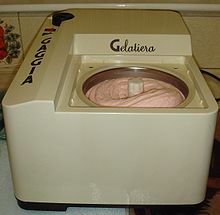Gaggia
This article needs additional citations for verification. (September 2014) |
| File:Gaggia-Logo.png | |
| Company type | Espresso Machine Manufacturer |
|---|---|
| Industry | Domestic & Professional Espresso machines |
| Founded | 1947 |
| Headquarters | Robecco sul Naviglio |
| Products | Espresso Machines |
| Parent | Philips |
| Website | www |

Gaggia is an Italian company that makes coffee machines, especially espresso and cappuccino machines, in addition to small kitchen appliances. The company is owned by Saeco International Group, a division of Dutch consumer electronics giant Philips.
History
The founder, Achille Gaggia, applied for a patent (patent number 365726) for the first modern steamless coffee machine on September 5, 1938, to be used commercially in his coffee bar. The machine forced water to flow over the coffee grounds at a high pressure, producing the 'crema' that is unique to espresso.
The Gaggia company was founded in 1947 and formally incorporated in 1948. It first produced machines for commercial use, but shortly thereafter released the Gilda, its first home machine.[1] The company continues to produce quality espresso machines (as well as accessories) from classic manual machines to the innovative super-automatic models recently added to the line. As of 2010, all Gaggia espresso and coffee machines are still manufactured in Milan at the Robecco sul Naviglio factory. The 2015 Gaggia Classic is built in Romania instead. The Gaggia S.p. A company was purchased in 1999 by fellow Italian competitor Saeco International Group, which in turn was purchased by Dutch manufacturer Philips in 2009. Gaggia still operates a separate line but now is using Saeco designs in some of its domestic espresso machines. Before the takeover by Philips most domestic espresso machines from Gaggia had aluminium boilers. Now they have stainless steel boilers.
See also
References
- ^ "1948 Gaggia Gilda Design Study". Retrieved 2 November 2014.
